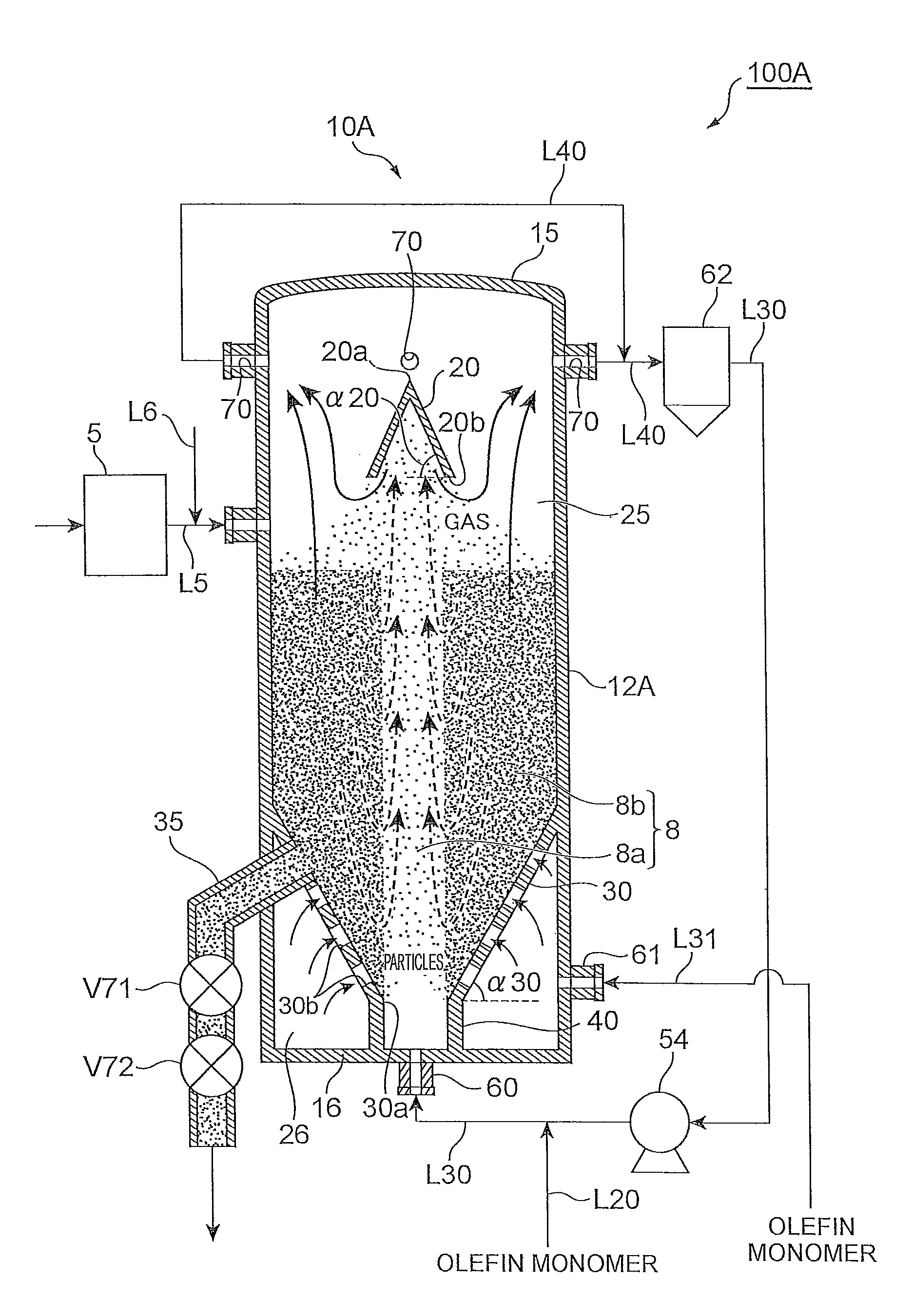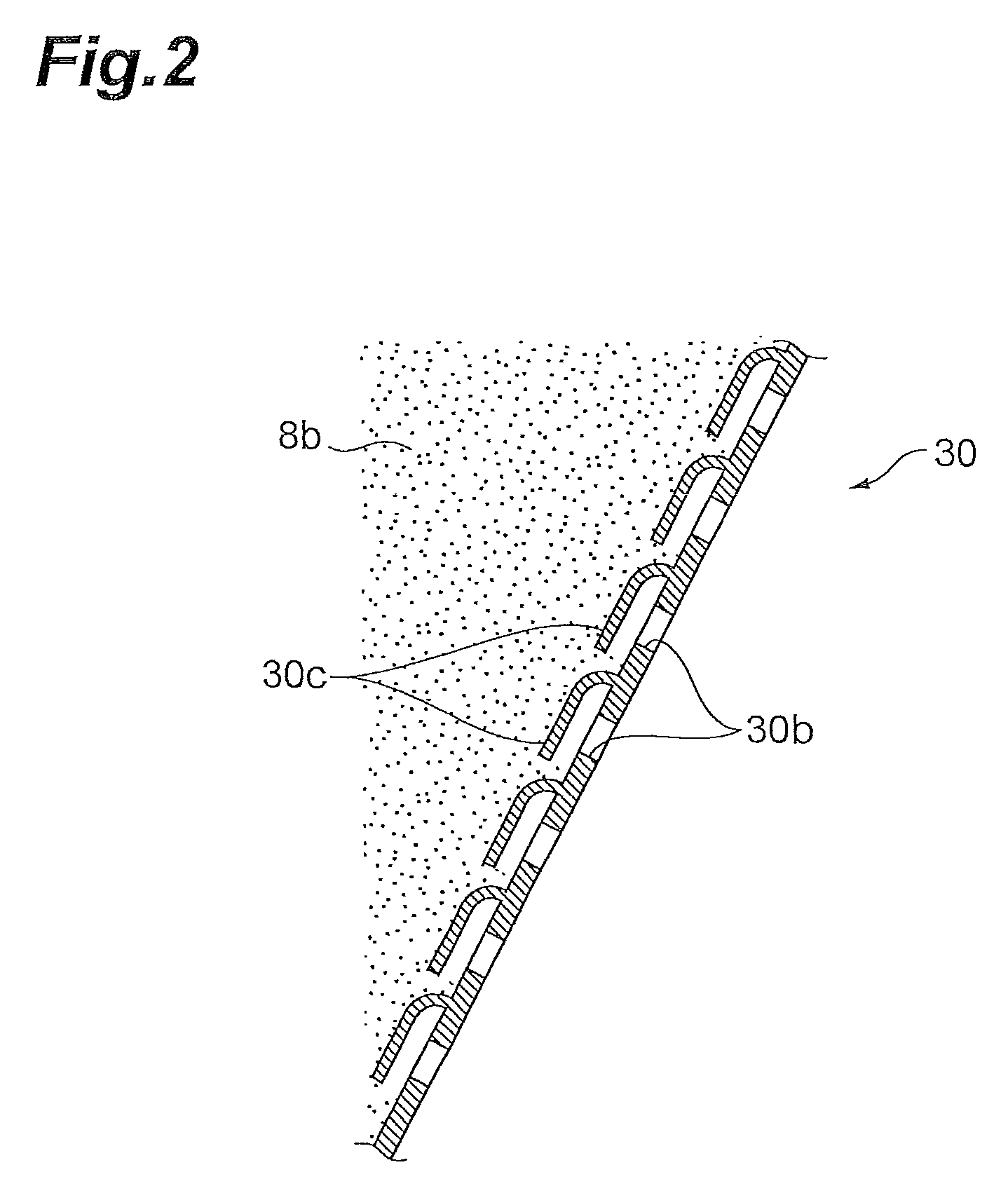Spouted-fluidized bed-type olefin polymerization reactor
a technology of olefin polymerization and fluidized bed, which is applied in the direction of chemical/physical/physical-chemical stationary reactors, chemical apparatus and processes, etc., can solve the problems of easy flow defects, increased gas flow rate, and small particle size of polyolefin particles obtained by polymerization, and achieves low blowing amount.
- Summary
- Abstract
- Description
- Claims
- Application Information
AI Technical Summary
Benefits of technology
Problems solved by technology
Method used
Image
Examples
first embodiment
Polyolefin Production System
[0047]FIG. 1 shows a polyolefin production system 100A according to the first embodiment. This production system 100A includes an olefin prepolymerization reactor 5 and an olefin polymerization reactor 10A which is connected as a subsequent stage to the olefin prepolymerization reactor 5.
[0048]Olefin Prepolymerization Reactor
[0049]The olefin prepolymerization reactor 5 polymerizes olefin in the presence of an olefin polymerization catalyst to form polyolefin particles.
[0050]Examples of the olefin prepolymerization reactor 5 include, but are not limited to, slurry polymerization reactors, bulk polymerization reactors, stirred tank-type gas phase polymerization reactors, and fluidized bed-type gas phase polymerization reactors. Any one of these reactors may be used alone, a plurality of reactors of the same type may be used in combination, or two or more reactors of differing types may be used in combination.
[0051]Slurry polymerization reactors that may be ...
second embodiment
[0147]A production system 100B shown in FIG. 3 has an olefin prepolymerization reactor 5 and an olefin polymerization reactor 10B. The olefin polymerization reactor 10B differs from the above-described reactor 10A in having a draft tube T1 disposed within the reaction zone 25. By using the draft tube T1, it is possible to form within the reaction zone 25 a spouted bed that has excellent stability and can further reduce the pressure loss.
[0148]The reactor 10B uses the draft tube T1 disposed within the reaction zone 25, enabling to obtain the gas composition within the draft tube T1 that is different from the gas composition outside the draft tube T1. The reactor 10B is equipped with a pipe L25 communicating with the inside of the draft tube T1, and a gas or a liquid is fed into the draft tube T1 through this pipe. For example, by obtaining a gas composition inside the draft tube T1 that has a hydrogen content lower than that in the gas composition outside the draft tube, it is possib...
third embodiment
[0149]A preferred arrangement of the polyolefin production system which employs a bulk polymerization reactor as the olefin prepolymerization reactor and employs an ejector system as the transferring means is described in detail while referring to FIG. 4. The polyolefin production system 100C shown in FIG. 4 includes a bulk polymerization reactor 5 and an olefin polymerization reaction 10C having at the interior both top and bottom reaction zones 25.
[0150]The bulk polymerization reactor 5 polymerizes an olefin in a liquid phase containing an olefin polymerization catalyst, thereby forming polyolefin particles. The polyolefin particles formed in the bulk polymerization reactor 5 pass together with liquid olefin through a line L5, and are fed to the olefin polymerization reactor 10C. A nozzle 68 for feeding a slurry to the top reaction zone 25 is provided, as shown in FIG. 4, at a position lower than the powder level 85 of the spouted bed. When the slurry is fed into the reaction zone...
PUM
| Property | Measurement | Unit |
|---|---|---|
| particle diameter | aaaaa | aaaaa |
| temperature | aaaaa | aaaaa |
| temperature | aaaaa | aaaaa |
Abstract
Description
Claims
Application Information
 Login to View More
Login to View More - R&D
- Intellectual Property
- Life Sciences
- Materials
- Tech Scout
- Unparalleled Data Quality
- Higher Quality Content
- 60% Fewer Hallucinations
Browse by: Latest US Patents, China's latest patents, Technical Efficacy Thesaurus, Application Domain, Technology Topic, Popular Technical Reports.
© 2025 PatSnap. All rights reserved.Legal|Privacy policy|Modern Slavery Act Transparency Statement|Sitemap|About US| Contact US: help@patsnap.com



